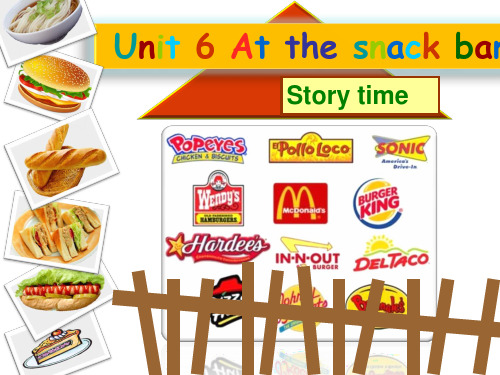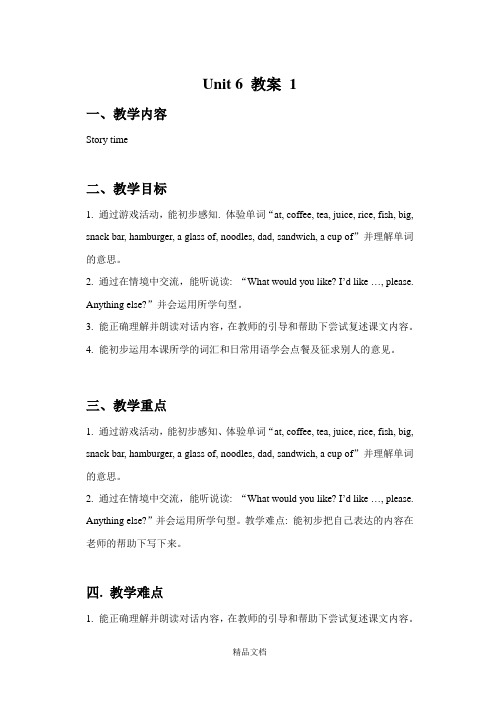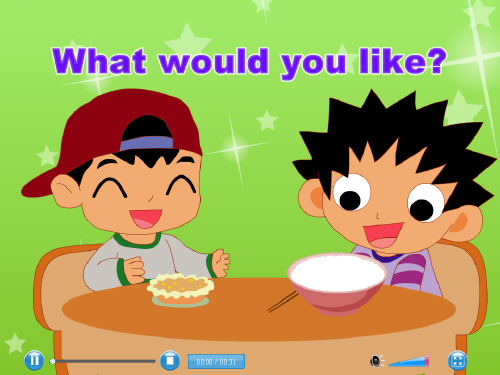【优质】小学英语译林牛津版四年级上册Unit 6 At the snack bar优质公开课教案 1
- 格式:doc
- 大小:47.50 KB
- 文档页数:7

![牛津译林英语四上《Unit 6 At the snack barA》[戴老师]【市一等奖】优质课](https://img.taocdn.com/s1/m/1f60d3c5700abb68a982fb99.png)
教学目标1. 知识和能力目标( 1 ) 能听懂、会说、会读noodles, hamburger, sandwich, a cup of coffee等词汇。
( 2 )能初步掌握日常交际用语:What would you like? I’d like … What about you? Anything else?( 3) 能整体理解故事内容,有感情地朗读并尝试表演故事。
2.情感态度目标通过故事的学习,树立健康饮食的习惯。
2学情分析本次教学的授课对象是小学四年级的学生,他们经过一年多的英语学习,已经储备了一定的英语语言知识,具备了简单的英语语言运用能力,也具有一定的自主、合作和探究的学习能力。
他们活泼好动,模仿表演能力强,能积极参与课堂活动,乐于表现自己。
3重点难点1. 掌握的单词noodles, sandwich,a glass of, a cup of的发音。
2. 灵活运用句型“What would you like? Anything else?”向别人征询意见进行交流。
3. 掌握对话中部分句子连读、升降调的朗读技巧。
4教学过程4.1 第一学时4.1.1教学活动活动1【导入】Activity one1.Enjoy a song (课前)Listen to the song and say.T: Do you like this song? What food or drinks can you hear from the song? (教授新单词hamburger sandwich juice milk)T: What other food or drinks can you name? (教授新单词rice noodles coffee tea)设计意图: 歌曲能迅速吸引学生的注意力,激发他们的学习兴趣,通过提问检测学生听歌曲的效果,激活学生脑中已有的知识储备,又为他们阅读和理解故事做好准备。

译林版)4A Unit 6 At the snack bar单元知识点及练习学一学】一、词组1.在小吃店:at the snack bar2.想要:would like3.一杯:a cup of4.一杯咖啡:a cup of coffee5.两杯茶:two cups of tea6.一杯:a glass of7.一杯牛奶:a glass of milk8.三杯果汁:three glasses of juice9.橙汁:orange juice10.四个三明治:four sandwiches11.一些米饭:some rice12.一些面条:some noodles二、句子1.----你想要什么。
----我想要一个汉堡和一杯牛奶。
2.你呢?=你要什么?3.还要别的吗?4.----我饿了。
----我也是。
5.这里有家小吃店。
6.我能为你效劳吗?7.多么大的一个鸡蛋!8.你能看见那个盒子吗?9.我看见盒子在狐狸夫人的后面。
10.它们都很美味。
三、知识点1.名词复数:大多数名词后面直接加s,但下列词后面要加es:box-boxesfox-foxesclass-classesglass-glassesmango-mangoessandwich-sandwiches2.不可数名词:coffee。
milk。
tea。
juice。
rice。
fish3.感叹句:What + a/an + 形容词 + 名词!What a nice skirt。
多么好看的裙子!What a cute panda。
多么可爱的熊猫!练一练】1.一、判断划线部分的字母发音是否相同,用“√”或“×”表示。
1.hurry - get ×2.egg - sofa ×3.fox - taxi √4.family - horse ×一、文章格式已修正,删除明显有问题的段落,改写如下:XXX is a cat。
I have a cat named Fluffy。


Unit 6 教案1一、教学内容Story time二、教学目标1. 通过游戏活动,能初步感知. 体验单词“at, coffee, tea, juice, rice, fish, big, snack bar, hamburger, a glass of, noodles, dad, sandwich, a cup of”并理解单词的意思。
2. 通过在情境中交流,能听说读: “What would you like? I’d like …, please. Anything else?”并会运用所学句型。
3. 能正确理解并朗读对话内容,在教师的引导和帮助下尝试复述课文内容。
4. 能初步运用本课所学的词汇和日常用语学会点餐及征求别人的意见。
三、教学重点1. 通过游戏活动,能初步感知、体验单词“at, coffee, tea, juice, rice, fish, big, snack bar, hamburger, a glass of, noodles, dad, sandwich, a cup of”并理解单词的意思。
2. 通过在情境中交流,能听说读: “What would you like? I’d like …, please. Anything else?”并会运用所学句型。
教学难点: 能初步把自己表达的内容在老师的帮助下写下来。
四. 教学难点1. 能正确理解并朗读对话内容,在教师的引导和帮助下尝试复述课文内容。
2. 能初步运用本课所学的词汇和日常用语学会点餐及征求别人的意见。
五、教学过程Step1 Greeting & Warm up1. 学生表演对话,要求用已经学过的语言编演。
教师可以采取评五角星的办法。
T: Hello, class. Today I have some food. Look, here they are.(出示小纸袋)T: Hello, ... Would you like a pie?S: No, thank you.T: What about a hot dog?S: Yes, please. Thank you.T: You are welcome.2. 用同样的方法问几个学生, 以旧带新,教学单词“a hamburger,a sandwich,some noodles”。

特色小吃
特色(Special Snacks)是不可缺少的一部分,并成为中国饮
食生活的主要内容之一。
每个地区都有着其独特的小吃,被称为当
地的特色小吃。
这种小吃,已经是一种在当地的,绝非只是在三餐
之间填饱肚子,追求不饿肚子的层次。
特色小吃就地取材,通常能
够突出反映当地的物资、气候及社会生活风貌。
经过若干年的发展,特色小吃成为了不可缺少的一部分,比如湖南平江的风味酱干,火
培鱼,、,的、、华飞四季旺、华飞四季旺,发展起来的、,的、、香油、,鸭脖、河南、、、云南过桥、、安徽米饺、等等
小吃迅速在全国各地发展,成为了小吃界一道道亮丽的风景线。
Unit 6 教案 1
一、教学内容
Story time
二、教学目标
1. 通过游戏活动,能初步感知. 体验单词“at, coffee, tea, juice, rice, fish, big, snack bar, hamburger, a glass of, noodles, dad, sandwich, a cup of”并理解单词的意思。
2. 通过在情境中交流,能听说读: “What would you like? I’d like …, please. Anything else?”并会运用所学句型。
3. 能正确理解并朗读对话内容,在教师的引导和帮助下尝试复述课文内容。
4. 能初步运用本课所学的词汇和日常用语学会点餐及征求别人的意见。
三、教学重点
1. 通过游戏活动,能初步感知、体验单词“at, coffee, tea, juice, rice, fish, big, snack bar, hamburger, a glass of, noodles, dad, sandwich, a cup of”并理解单词的意思。
2. 通过在情境中交流,能听说读: “What would you like? I’d like …, please. Anything else?”并会运用所学句型。
教学难点: 能初步把自己表达的内容在老师的帮助下写下来。
四. 教学难点
1. 能正确理解并朗读对话内容,在教师的引导和帮助下尝试复述课文内容。
2. 能初步运用本课所学的词汇和日常用语学会点餐及征求别人的意见。
五、教学过程
Step1 Greeting & Warm up
1. 学生表演对话,要求用已经学过的语言编演。
教师可以采取评五角星的办法。
T: Hello, class. Today I have some food. Look, here they are.(出示小纸袋)
T: Hello, ... Would you like a pie?
S: No, thank you.
T: What about a hot dog?
S: Yes, please. Thank you.
T: You are welcome.
2. 用同样的方法问几个学生, 以旧带新,教学单词“a hamburger,a sandwich,some noodles”。
3. Read the words: “a hamburger, a sandwich, some noodles”
Practice in pairs. Act the dialogue.
Step 2 Presentation
1. T: Oh dear. I’m very hungry. Are you hungry? S: Yes.
T: Well, let’s go to a snack bar. 导入课题: “At the snack bar”。
S: Read the topic together.
T: Would you like some noodles?
S: No, thanks.
T: What would you like?
S: I’d like some rice.
T: What about you, …?
S: I’d like a glass of milk.
询问两、三个学生后,教师板书:What would you like? What about you?
Teach: “rice, a glass of milk”. Read one by one. Teach: “What would you like? What about you?”. Read one by one.
2. 出示图片引导学生问答。
T: What would you like?
S: I’d like a glass of juice.
T: Anything else?
S: A cup of coffee and a cup of tea.
Teach: “anything else, a cup of coffee, a cup of tea, a glass of juice” Read one by one.
3. 师生示范串联对话
T: What would you like?
S: I’d like a hamburger.
T: What about you?
S: I’d like a sandwich.
T: Anything else?
S: A glass of juice.
T: Here you are .
Work in pairs.
Act the dialogue.
Step 3 Story time
1. Listen to the tape and think:
T: Where are Mike, Helen and their dad?
S: They are at the snack bar.
再次揭题:Today we’ll learn a new lesson “At the snack bar”.
S: Read the topic.
2. Watch the cartoon.
T: Where would Mike like?
S: He’d like a hamburger and a glass of milk.
T: Where would Helen like?
S: She’d like some noodles.
T: What would dad like?
S: He’d like a sandwich and a cup of coffee.
2. Watch the cartoon again and finish the table. What do they want to eat? 完成信息表格。
S: What would Mike like?
S: He would like a glass of milk and a hamburger. S: What would Helen like?
S: She would like some noodles.
S: What would Mr. Brown like?
S: He would like a sandwich and a cup of coffee.
3. Listen to the tape and read after it. ( 注意模仿其语音语调。
)
4. Read in three. (分角色朗读对话。
)
5. Act the dialogue. (小组表演展示对话。
)
Step 4 Consolidation
1. 再次读课文将对话改编成短文进行填空。
Mike, Helen and their father are at the . They are . They would like some and . Mike would like a glass of and a . Helen would like some . Mr. Brown would like a and a cup of .
2. 模拟场景创编对话。
Show some pictures of food and drinks.
Ask each other and act the dialogue in groups. ( 仿照课文,创编点餐对话。
)。